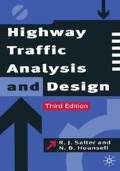Abstract
Once the transportation survey has collected all the details of the existing trip-making pattern and the socio-economic, land-use and transportation-system characteristics of the survey area, the second stage in the transportation planning process is the development of relationships between the total number of trip origins and destinations in a zone and the total characteristics. It is assumed that these relationships will be true in the future and so, if land-use and socio-economic factors can be predicted, future trips can be estimated for any proposed transport system.
Preview
Unable to display preview. Download preview PDF.
References
J. M. Harwood and V. Miller, Urban Traffic Planning, Printerhall, London (1964)
H. J. Wootton and G. W. Pick, Travel estimates from census data, Traff. Engng Control, 9 (1967), 142–5
G. W. Pick and J. Gill, New developments in category analysis, PRTC Symposium, London (1970)
Department of Transport, Traffic Appraisal Manual, London (1982)
Author information
Authors and Affiliations
Copyright information
© 1996 Y. Salter and N. B. Hounsell
About this chapter
Cite this chapter
Salter, R.J. (1996). Trip generation. In: Highway Traffic Analysis and Design. Palgrave, London. https://doi.org/10.1007/978-1-349-13423-6_6
Download citation
DOI: https://doi.org/10.1007/978-1-349-13423-6_6
Publisher Name: Palgrave, London
Print ISBN: 978-0-333-60903-3
Online ISBN: 978-1-349-13423-6
eBook Packages: EngineeringEngineering (R0)

